
17-20 September 2015. The phone alarm starts singing. I moan quietly then suddenly I’m wide awake. It is 3.30 in the morning and today is the day we take a hot air balloon ride. Neither of us has ever done this before. Excited! We wash and dress quickly and wait outside to be collected. We are taken to a central meeting point. After an unremarkable breakfast with many other people we go to the launch site a little way outside the town of Goreme.
In the early morning darkness we see the balloons spread out on the ground. We watch fascinated as one by one the burners are lit creating a golden glow. As the hot air fills each balloon it slowly expands and becomes upright, tethered to the earth by ropes.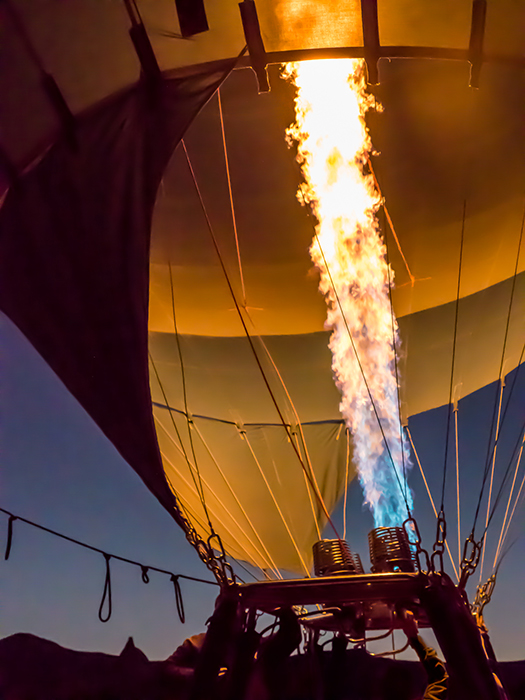

We climb aboard, about twenty of us. The basket is divided into six sections: four corners, and one on either side. I’m determined to get a corner rather than a side compartment for the best view. We lift off, so gently I hardly even realize we are in the air. We are gliding silently up and up as the sun rises over one of the most surreal landscapes I have ever seen.
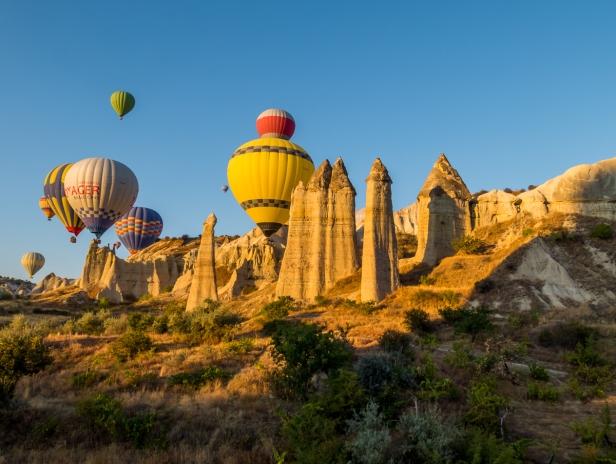
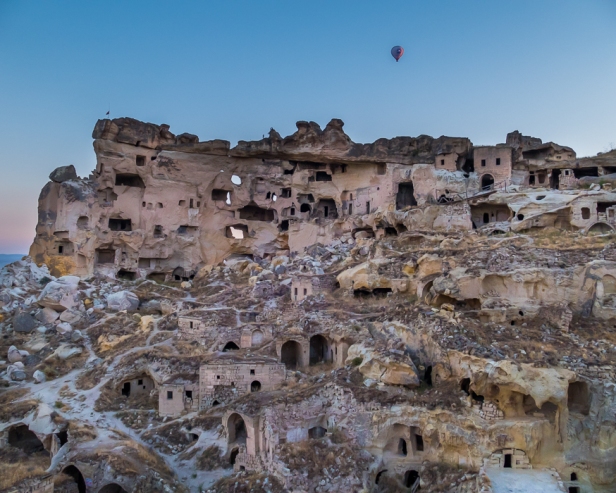
Watching the pilots manoeuver the huge balloons around each other and around the rock chimneys is a thing of beauty. It takes huge skill. Hot air balloons cannot be steered. Only the height can be adjusted with bursts of fire from the burner to put more heat into the balloon. They travel in the direction of the wind. The wind close to the ground can be different both in speed and direction from the wind even a couple of hundred metres higher. We go as high as 650 metres (nearly half a mile) at one point, looking out over the whole landscape and all the balloons below us. I think there must about one hundred of them.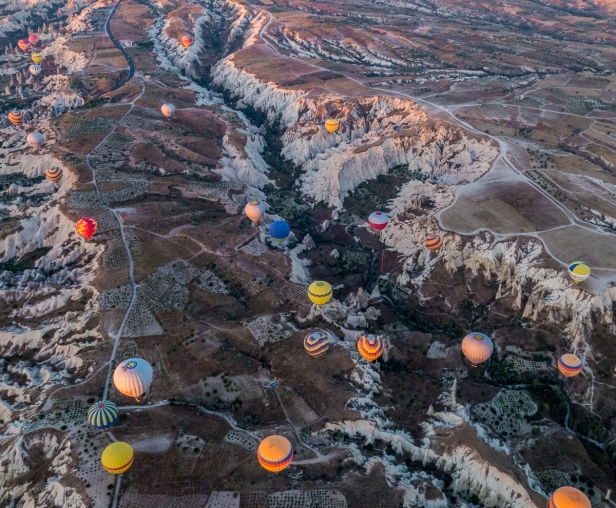
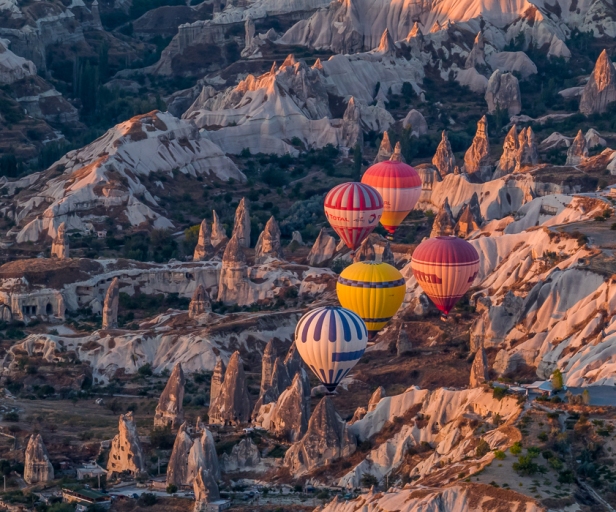
We float over the landscape with its plateaus and valleys. Suddenly I realize we are only a metre or so off the ground. At another point the basket scrapes the top of a tree as our pilot maneuvers the balloon for us to get the best view of the landscape.
Our pilot is from Germany, an ex airline pilot. He says he watches the other balloons above and below him to see the direction of the wind. At times it is a bit cramped with me and Don and another couple in our small corner section of the basket, but overall the view is open and clear. We float, there is no bumping, just a slow drifting along by the pink valley, and later along by the Love Valley so close to the chimneys we can almost touch them. I’m surprised by how close we go to some of the rock formations, and to some of the other balloons.
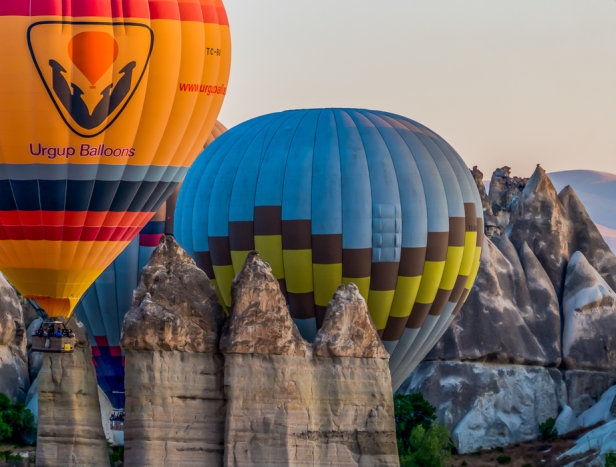
I watch as a balloon heads straight for one of the rock chimneys and wonder if the pilot will get it high enough in time to avoid crashing into it. He does. Just. The way the pilots make the balloons dance is almost like watching a ballet. It takes enormous kill and precision. Our landing is smooth and perfect, directly on top of the trailer waiting to tow it back to town. How does he do that? Given that it’s not possible to steer the balloon it’s an impressive feat.
We climb out and in the morning sun we drink champagne and toast the pilot, and this magical experience.
Some time between three and sixty-six million years ago three volcanoes began continuously erupting in central Turkey depositing a layer of ash, lava and basalt over a large area now known as Cappadocia. It solidified into a soft rock called tuff, covering the earth 150 metres (500ft) deep. Over the millennia the erosion of the tuff by snow, freezing, wind, and especially by rain and rivers, has created one of the most surreal and unique landscapes in the world. The weathering has left only the harder elements behind, forming an enchanted landscape of cones, pillars, pinnacles, mushrooms, and chimneys, which reach up to 40 meters (130ft) into the sky.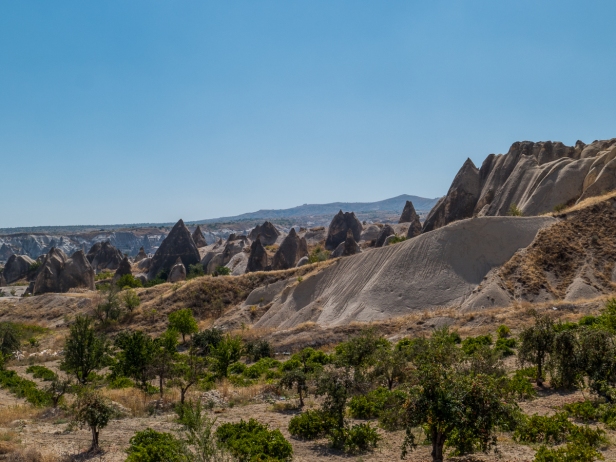


Nature created the landscape and people took it further. Discovering that the tuff is soft enough to carve, thousands of years ago people began carving dwellings in the rock, both in the cones and chimneys and underground. The entire area is honeycombed with tunnels and hand-hewn caves many floors deep. Underground there are living quarters, storerooms, stables and temples.
As long ago as 1800 to 1200 BC the Hittites needed a place to hide from the warring Greek and Persian Empires. Later the caves became a refuge during the early days of Christianity when those fleeing Rome established monasteries here.
We go exploring in Derinkuyu underground city. Down and down and down in the dark winding tunnels. Some of the tunnels are barely wider than we are, some so low we have to bend over to get through them. Lighting is dim and sporadic.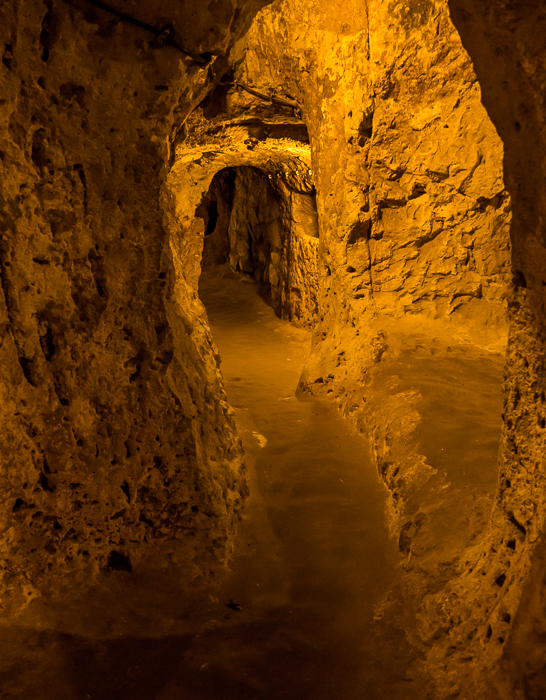
This ancient city is 60 metres (200 feet) deep, carved into the soft rock. To put that into perspective, 60 metres is the equivalent of a fifteen-story building. At one time it sheltered as many as twenty thousand people and their livestock. There are rooms carved out for stables, cellars, food storage, oil presses, refectories, and chapels. There is a large 55 metre (180 foot) ventilation shaft. An entire city hidden underground. And it is only one of several in Cappadocia.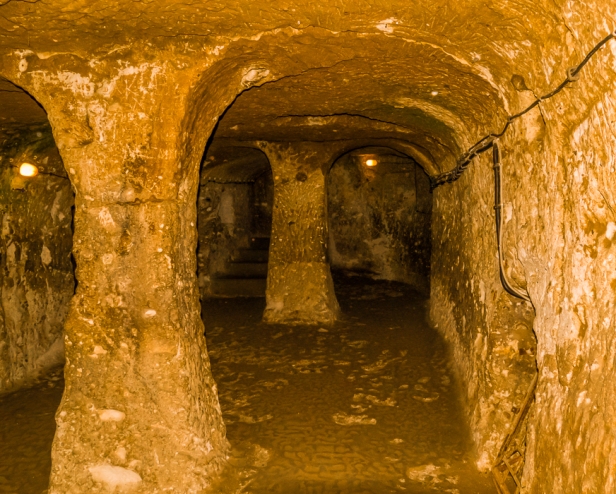
Derinkuyu is the largest excavated underground city in Turkey. It could be closed from the inside with large stone doors, and each floor could be closed off separately. It was a safe haven from the warring factions above ground. It reminded me of the underground tunnels and dwellings built more recently in Vietnam.
Next day, having been given a map, we go hiking up a cobbled road on the edge of town, looking for the trail into the Love Valley to see the chimneys up close.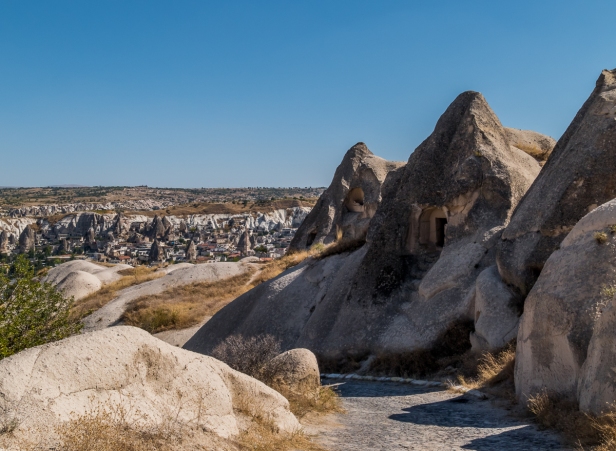
Right at the beginning there are some abandoned cave dwellings and we climb inside one of them. It is scary – exciting, and fascinating. We have no idea what we’ll encounter. We have no idea if we should go in or not.
Stepping inside we find the entire interior of the cone has been hollowed out except for a layer of rock creating upper and lower rooms. There is a hole in the ceiling and we climb up on the stone step and have a look in the upper level of the space. It is clear it has been used fairly recently. There are old newspapers, clothes, an empty drink can. It’s fascinating to finally see inside one of the cave dwellings even if it has been abandoned.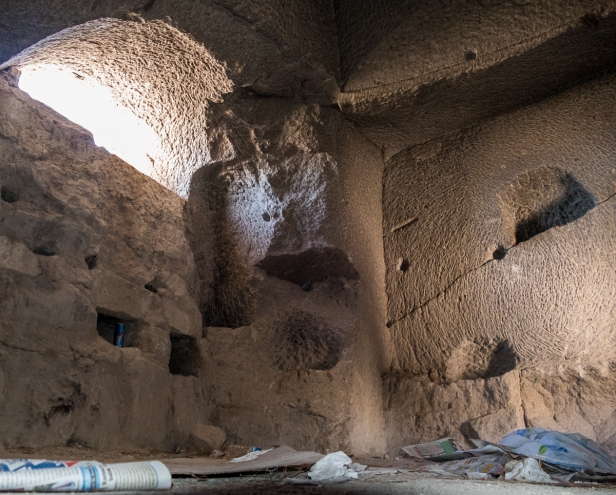
We never do find the trail down into the Love Valley. The man at the tour company made it look so easy showing us the trail on the map and saying there would be red arrows, but we find no red arrows. The cobbles give way to a dirt track that keeps branching and the map isn’t detailed enough to indicate which branch to take. Finally we abandon the tracks and set out across country to get to the cliff edge to look down into the valley.
Going cross country, past very sad looking grape plantations with a few grapes withering on the vine, past a few olive trees with small hard new olives on them, past sparsely planted apricot trees, we make sure we can find our way back by using markers: a dead tree, a lone tall white flower looking very much like hollyhock, a squashed cigarette packet on the trail. I sing Irish folk songs as we walk along. We see the rock chimneys of Love Valley directly in front of us but we can’t get down to them.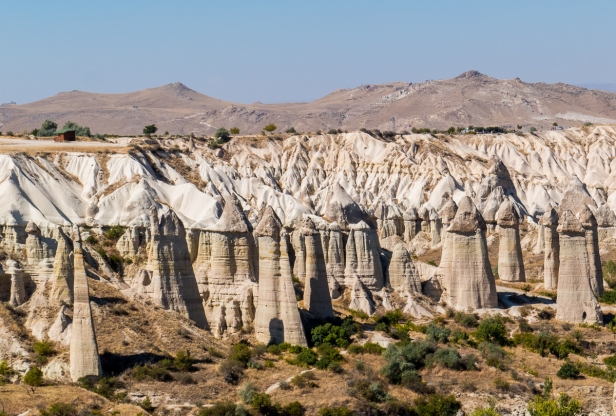
At the cliff edge we decided to walk along it for a way. Don spots a broken bottle top with a blue neck and lid. He pushes it broken-side-down into the dirt to mark the spot where we need to turn and go back past the vines, and the sad tomato plants, and the bright orange pumpkins, and find our way back to the track we’d started on.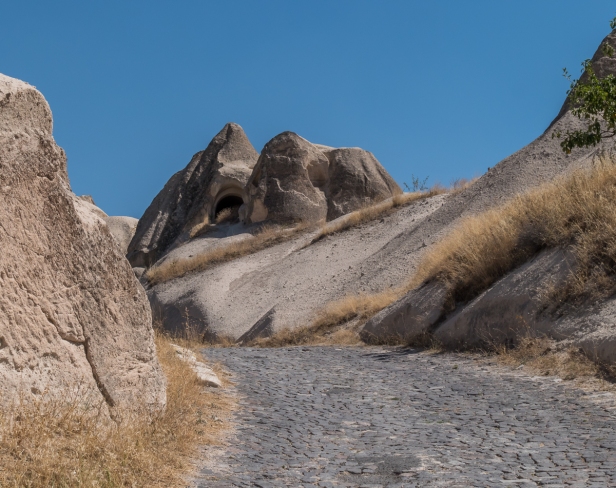
On the way back I climb up to go inside another of the abandoned caves. It’s an almost vertical climb, but my shoes have good grip, and the rock surface is rough enough that I can climb easily. Inside the cone there is a single room with two openings.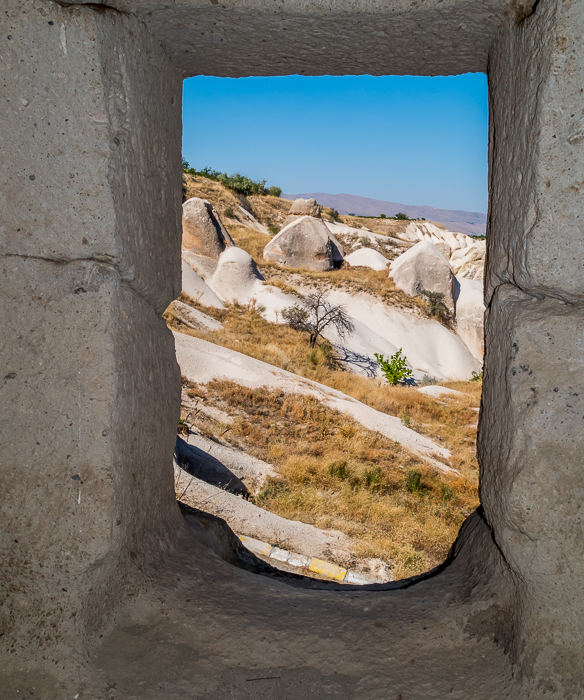
On the bus ride from Konya to Goreme we’d noticed endless fields of something orange and wondered what the crop was. In town the mystery is solved. Pumpkins. They are grown only for the seeds. The seeds are mixed with salt and milk and baked in the oven to create a popular snack. I never did find out the Turkish name for it, or get to taste it.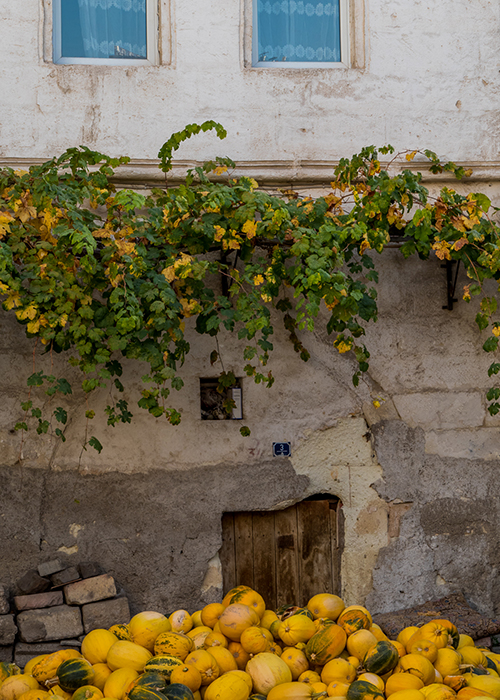
The charming honey-coloured village of Goreme sits in the centre of the Cappadocia region. What was once a farming hamlet has become a tourist hub for exploring Cappadocia, yet it still retains its rural charm. Not all of the troglodyte dwellings are museums, or abandoned. Many people still live in traditional homes carved from the chimneys and cones.

Goreme by night from our hotel balcony.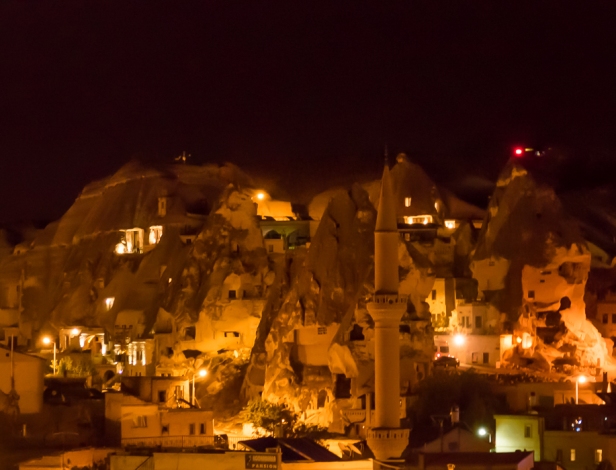
At the end of the Ihlara Valley,
twenty-eight kilometres from Aksarai is the rock-cut monastery in Selime dating from the eighth century.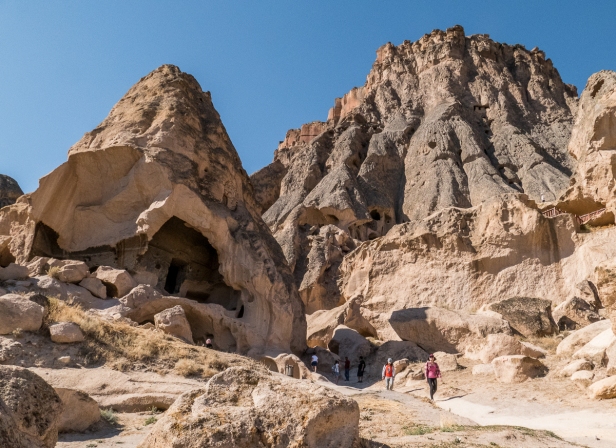

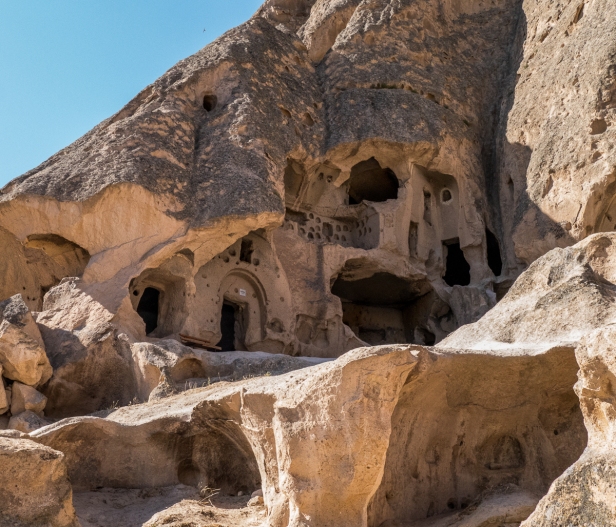
The monastery contains a large cathedral, monks’ quarters, kitchen, and a stable for mules – all cut from the rock. It is a maze of rooms hewn from the tuff cones and chimneys. The workmanship and detail is astonishing.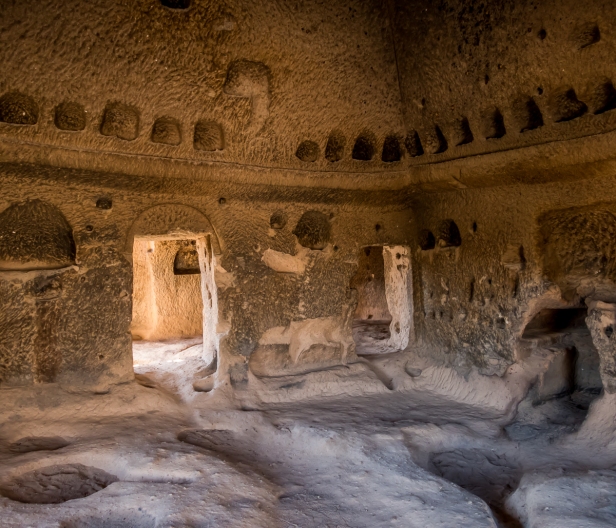
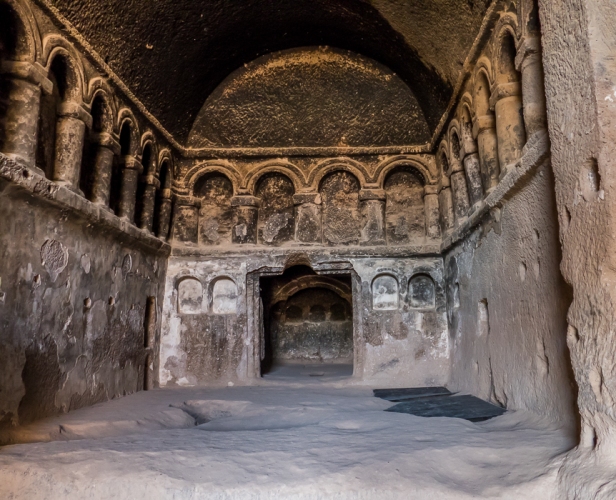
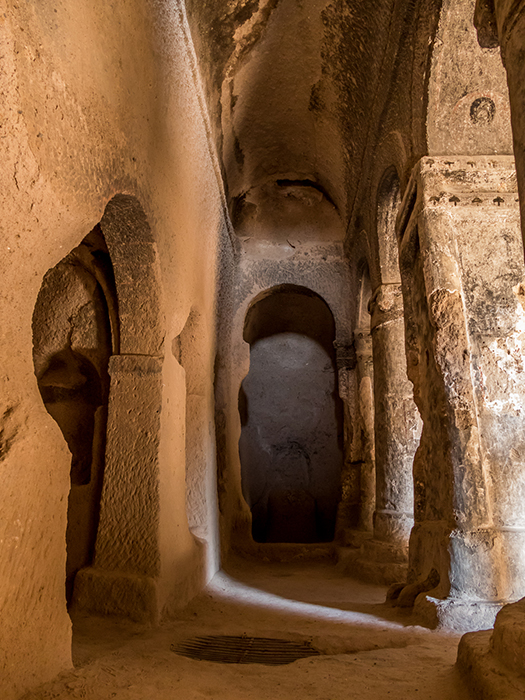
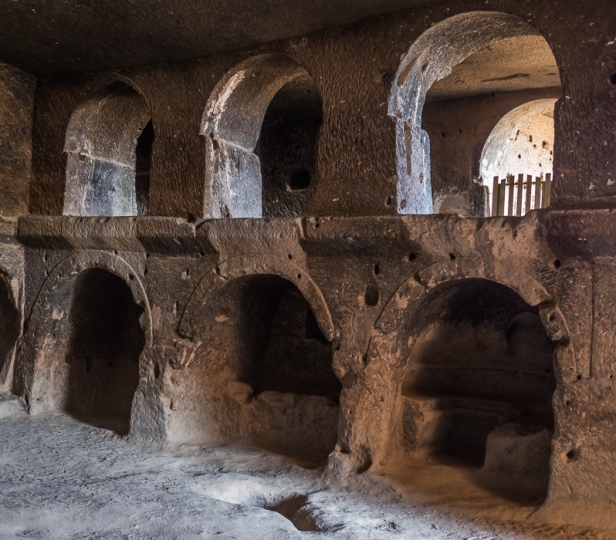

The top is a fortress, and there are a series of secret tunnels and ever-steeper rock stairways and ladders. We follow them to the top, exploring everywhere we can get to.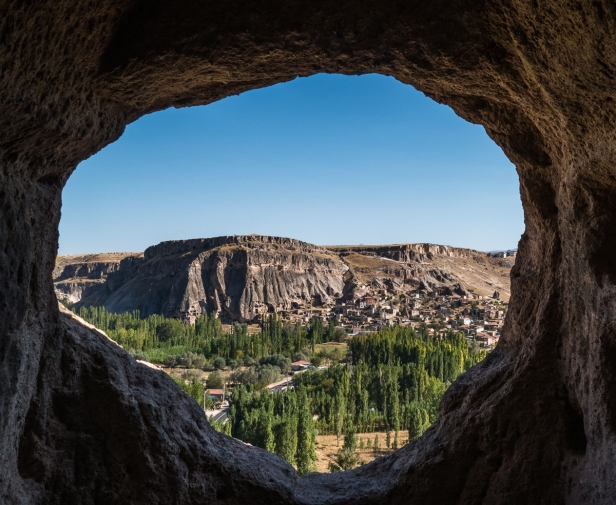
We eat dinner in the same restaurant every night we are in Goreme. Cappadocia Cuisine is close to home and inexpensive with good service and good food. A winner. Why go looking elsewhere? Most nights we eat clay pot casserole, which is served with rice and salad. The dish is common in central Turkey and dates from the Ottoman Empire. The ingredients are lamb shoulder or chicken, tomato sauce, wild mushrooms, shallots, garlic, green pepper and other vegetables, young potatoes and vegetable stock. It is cooked slowly, and heated in individual servings in a clay pot called a testi. The casserole is poured into the testi, the top sealed with bread dough, and then heated in a wood fired pizza-style oven. The top half of the pot is knocked off with a special knife by the server at the table, revealing the steaming aromatic dish. You can see the top half of the pot covered in burnt bread dough at the bottom right of the picture.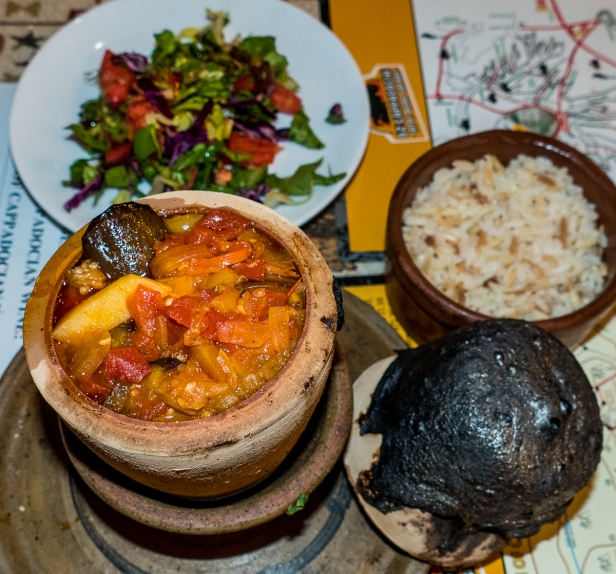
We try again to find one of the many hiking trails leading out from town. The maps are inadequate and there is no signage. I think the people of Goreme don’t want us to be able to find our way around the countryside. We walk a long way out of town trying to find the entrance to a trail leading through some valleys. We walk about four or five kilometres along the dusty shoulder of a fairly busy road. It’s not pleasant, and we never do find the trail, though we try a few that could be possibilities. I think we aren’t even in the region really. We walk back along the road, and try again closer to where we think the trail head should be, but the map we were given and the map on the phone are contradictory and we can’t make any sense of it. The heat is intense, and we know we don’t have enough water with us. If we’d been able to find the beginning of the trail easily it would have been a beautiful walk to another nearby village. Finally we give up and come home after stopping for a much-needed iced tea at the first place we come to. Exhausted. The water in our bottles is now warm. We covered about twelve kilometres, most of it alongside a road. Not so much fun. Later we hiked up to the top of the high plateau on one side of the town for sunset.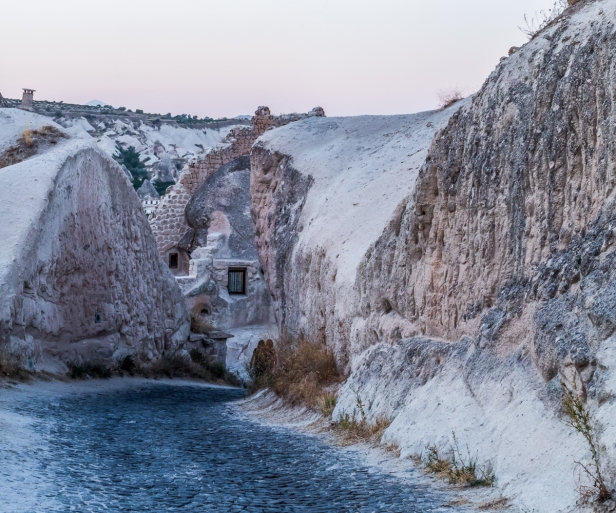
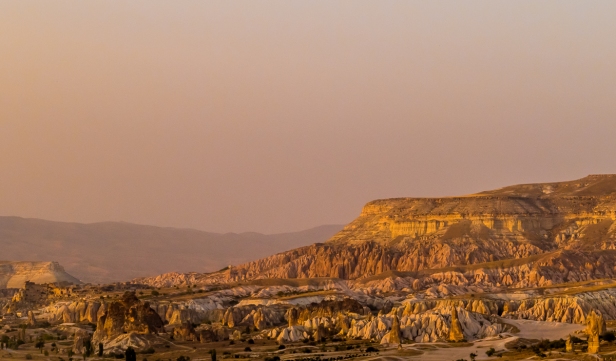
Next post: more of the wonders of Cappadocia – exquisite Byzantine churches hidden inside the rock cones, the place of pigeons, and pottery.
All words and images by Alison Louise Armstrong unless otherwise noted
© Alison Louise Armstrong and Adventures in Wonderland – a pilgrimage of the heart, 2010-2016.

This has definitely set my sights on Turkey! Great photos too 🙂
LikeLiked by 2 people
Thanks so much. Turkey is definitely worth visiting – it’s an amazing country.
Alison
LikeLike
Wow! These photos are so amazing! That place is so photogenic, I’ve never seen a bad photo of that place and you have some very interesting and unique perspectives too. Wonderful post.
LikeLiked by 2 people
Thanks so much Mani. I agree – Cappadocia must be one of the most photogenic places on earth. It’s so surreal.
Alison
LikeLike
Magical photography of a stunning part of the world Alison. Wonderful!
LikeLiked by 2 people
Thank you so much Cindy. It is indeed a stunning part of the world, and very photogenic! We loved it. How could you not?!
Alison
LikeLike
Fascinating. Especially the balloon riding among all those pillars! Up there in that device is a place you will never find me but it’s nice to know people who are brave enough. 🙂
LikeLiked by 2 people
Thanks Kate. That balloon ride was spectacular! You should try it sometime 🙂
Alison
LikeLike
Oh my goodness, Alison. Those photos are just perfection. I’m giving myself a quiet day just to absorb your last two posts. Total decadence. I still can’t believe how lucky I am that Megan put me on to your blog and that we had that lovely day in Manuka getting to know each other. And now I don’t have to feel frustrated that I’m unable to visit all those fascinating countries as you and Don do it for me and I’m sure see and teach me so much that I’d probably miss. As always, a huge thank you and warmest wishes,
Ros
LikeLiked by 2 people
Thank you so much Ros. I’m glad you’re enjoying the stories of our travels. We had a lovely day in Manuka and I’m delighted that you follow our adventures through the blog.
Alison
LikeLike
Beautiful photo’s ! I loved the hot air balloon ride but was nervous that we where going to hit another balloon ,we to landed safely on the back of the truck ….amazing experience
LikeLiked by 2 people
Thanks so much Marianne. Yes the balloon ride was really amazing. I don’t remember being nervous at all, and I often am when flying in planes. I guess those pilots really know how to land the balloons on the trailers. I don’t know how they’d get them up there otherwise.
Alison
LikeLike
Oh, you’ve put my Goreme, Cappadocia, and balloon photos to shame! And I’m more than OK with that! How fun it is see this landscape again and remember our cold January stay there. Our balloon ride seemed much less crowded (I’m sure because it was so frigid and the tourist numbers were way down); I loved seeing all the balloons crowded together on your ride. We, too, kept trying to find pathways and failed – perhaps your hypothesis is correct! Looking forward to more posts from the area.
LikeLiked by 2 people
Wow, thanks Lexie for that wonderful compliment! I bet you have some great pics of Cappadocia. I’d imagine it was all quite different in January, and that it was a very cold balloon ride. I’m so glad we got to go there – it was kind of a bucket list item. Ah the hiking . . . . . . so frustrating, but at least it got us out of town and rambling around in the countryside.
Alison
LikeLike
What an incredible place! Your pictures are stunning. 🙂 I would love to visit the area someday. Thanks for sharing.
LikeLiked by 2 people
Thanks Louise. Yes it is an incredible place. Definitely worth visiting!
Alison
LikeLiked by 1 person
This is one of my favorite of your posts. The photos are truly amazing, the landscape SO interesting, and I followed your journeys with special interest. The rock dwellings remind me of the Anasazi ones of the American Southwest – only these are more amazing. I can only imagine what it was like to see these formations in real life.
LikeLiked by 2 people
Thanks Kay! It always makes me feel good when someone really likes a post. It truly was amazing exploring all the cave dwellings, both the bigger ones we did with a guide, and those little ones that we scrambled into on our own. Fun!
Alison
LikeLike
Super pics and writing… as usual. I love troglodyte homes, especially when interspersed with more modern dwellings. Loved the ones in Spain… near Toledo and down near Granada.
LikeLiked by 2 people
Thanks Keith. I’m fascinated with troglodyte homes, but haven’t been to many. There are some in Australia at Coober Pedy. We were staying near Granada a few years ago but didn’t know about the troglodyte dwellings. Also I remember seeing some from a train ride in France in the Loire Valley.
Alison
LikeLike
These photos are amazing! I will have to add this place to my bucket list! Thanks for sharing!
LikeLiked by 2 people
Thank you so much Beth. And you’re welcome! Cappadocia is definitely worth visiting. It’s really extraordinary.
Alison
LikeLike
Someone told me that the hot air balloon ride in Cappadocia was the best in the world, and Bagan came in second place. I have never had any experience riding a hot air balloon before, but I would really love to do that one day. 650 meter above the ground on a hot air balloon sounds very high, especially with all those other balloons look so small below.
The rock-cut monastery looks so beautiful. I’m glad that even though you couldn’t find your way to the Love Valley and the countryside as you wished, you still managed to visit some impressive ancient sites there.
LikeLiked by 2 people
You really should do a hot air balloon ride one day Bama. It’s an amazing experience. The way the pilot’s manoeuvre them is really remarkable. We didn’t do it in Bagan. I don’t know why not, but I’m sure glad we did it in Cappadocia. All the rock cut dwellings we visited were quite remarkable. In the next post I’ll be showing Byzantine churches with really beautiful frescoes. And we enjoyed our time rambling around the countryside even if we didn’t get to where we thought we were going.
Alison
LikeLike
Okay, that’s it, Turkey’s officially on my bucket list. That landscape is so amazing. And the food! x
LikeLiked by 2 people
Yeah SGMT, you gotta go to Turkey! It’s fabulous. I bet you could work out a really super 10 day itinerary to hit the highlights.
Aliosn xo
LikeLiked by 1 person
Great story and photos, especially the balloon shots. Who knew something so hot could be so cool.
LikeLiked by 2 people
Thanks Dave. Yes that balloon ride was *very* cool! 🙂
Alison
LikeLike
Alison thanks for this great post. I knew about Cappadocia and have thought I would like to go there. So many beautiful photos and it is stunning. The post is very informative. The balloon adventure stunning and knowing me i would be beside myself thinking i was going to crash into one of those pointy things but you have allayed my fears before I start out! You really have sold me on the place. And made me hungry as well. Stay safe.
LikeLiked by 2 people
Thank you so much Louise. Cappadocia is a truly remarkable place and really worth visiting, and the balloon ride one of the best things we’ve ever done. I hope you get to go there one day.
Alison
LikeLiked by 1 person
Great pics Alison. I bet the balloon ride busted the old daily budget!
LikeLiked by 2 people
Thanks Carlton. Yes, the balloon ride was expensive, but so worth it!
Alison
LikeLike
I love Cappadocia and know exactly what you mean about the maps and trails. After trying once on our own and getting lost, we hired a guide. Beautiful photos!
LikeLiked by 2 people
Thanks Anne. Lexklein said the same thing about the trails. I was annoyed a bit that we were told there would be markers and there weren’t any. But we had a pretty good time anyway.
Alison
LikeLike
If my bucket list had a top place Cappadocia would be right there and your marvelous photos have me longing for a ride in a hot air balloon over that amazing landscape. Truly magical and an experience that has to be one of the highpoints of all of your adventures! Anita
LikeLiked by 2 people
Thanks so much Anita. You must go! It really was a highpoint – the balloon ride, and all of Cappadocia. As if all I shared in this post wasn’t enough, the next post will include some beautiful Byzantine churches carved into the rock. Gorgeous!
Alison
LikeLike
Wonderful post Alison. It truly looks a magical place and your photography is beautiful. The hot air balloon experience must certainly been one to remember. Tim & Anne
LikeLiked by 2 people
Thanks Anne. The whole experience in Cappadocia was fabulous. It made up for Pamukkale! I’d been wanting to try the hot air balloon thing for years. So glad I finally got to do it.
Alison
LikeLiked by 1 person
What a totally enchanting place. It remains one of my all time favourite travel highlights. I wish we had done the balloon ride. All your photos are stunning and I particularly love the one of the blue balloon coming between the rock chimneys…scary, beautiful!
LikeLiked by 2 people
Thanks so much Caroline. I was stunned to see those balloons so close to the rock pinnacles. And then one of the balloons only just made it up and over without hitting one. I think you need to go back to do the balloon ride 🙂
Alison
LikeLike
Oh, my. I don’t really have the words. Just oh, my. ;))
LikeLiked by 2 people
Yeah, really! The whole place, and our experience there was magical. It’s a truly spectacular landscape.
Alison
LikeLiked by 1 person
so glad you had that lovely expereince
LikeLiked by 1 person
Your photography is always beautiful, but these photos, especially the balloons, are magnificent.
LikeLiked by 2 people
Thanks so much Angeline! What a wonderful compliment. I was so hoping to get some good shots of the balloons. They were better than I’d hoped for – especially the ones that are just about touching the pinnacles. I never knew they’d get so close. Maybe we’ll see you in the jardin tomorrow night – should be a party there I would think.
Alison
LikeLike
Hi Alison and Don,
The early morning photos by both of you of the balloons are just magical for me. As are the ones with balloons all around and below you. What an amazing experience as were the rest of your stories and photos.
I personally love how you take us right into the adventure, while honestly sharing the ups and downs of your personal experience. How inspiring for all of us.
Cheers,
David
LikeLiked by 2 people
Thanks so much David. It was a magical experience. We’re so glad we decided to do the balloon ride. And I’m glad you felt like you were along on the adventure with us.
Cheers, Alison
LikeLike
Wow!! 😍
LikeLiked by 2 people
Thanks Denice. It’s definitely a wow place. We were endlessly amazed.
Alison
LikeLiked by 1 person
The balloon shots in the half light are simply amazing, Allison. What a landscape for a backdrop! Very jealous. 🙂 A happy Easter to you and Don! Any plans?
LikeLiked by 2 people
Thanks Jo. It’s such an extraordinary landscape, hard to take a bad picture. You must go there one day! Happy Easter to you too. We’re in San Miguel de Allende, Mexico and Semana Santa (Holy Week) is a big deal here. Tonight we will go to the Jardin Principale (main square) where there will be a short religious parade, and no doubt a big party. Tomorrow morning we’ll be going back to the jardin where they will blow up a number of Judases. It’s all go.
Alison
LikeLiked by 1 person
No sympathy! 🙂 🙂
LikeLiked by 2 people
All these photos are beautiful, but those from the balloon flight are exceptional.
LikeLiked by 2 people
Thanks so much Jeff. I am thrilled with the balloon shots. I got what I was hoping to get. (Unlike Pamukkale ha ha).
Alison
LikeLiked by 1 person
Alison, your shots are spellbinding – I have never been to Cappadocia myself, but from all the comments it sounds like you really did the place justice. The colours and landscapes pretty much leap out of the screen. I did not know the balloons would come *that* close to the rock chimneys! And the clay pot casserole looks divine – I can see why you and Don went back for it every night.
LikeLiked by 2 people
Thanks so much James. Cappadocia is one of the most fabulous places in the world! Definitely worth visiting. I didn’t know the balloons would go that close to the rock chimneys either! And yes, the clay pot dinner was delicious.
Alison
LikeLike
What an amazing adventure, and the photos are breathtaking, I can’t get over the monastery, it appears a very spiritual place. One day I will get there, (inspired by this blog)…
LikeLiked by 2 people
Thank you so much Anne. The monastery was very special. I’d love to have been able to be there without crowds and time constraints – I think it would have been quite magical. As it was it was exhilarating enough just exploring – it’s huge and like a rabbit warren with passageways and tunnels everywhere. I hope you get there!
Alison
LikeLiked by 1 person
Decades ago the hubby and I drove all night to arrive at dawn for the inflation of the balloons at the Albuquerque (New Mexico) Balloon Fiesta. The sound and smell of the burners, the half-light of dawn and the eerie flashing flame as the balloon inflates – all brought back with your photos. Well done. We’ve never been up in a balloon however, very brave of you.
LikeLiked by 2 people
Thanks Pam. It’s an amazing sight isn’t it – watching all the reparation. It didn’t feel brave. I guess I just trusted that they knew what they were doing, and so it proved. You should do it one day! It really is an incredible experience.
Alison
LikeLike
I have acrophobia, so hot air balloons are not for me. Many of the places you have traveled involve heights, a problem in my personal enjoyment of those locations. However, I can experience all through your photos and text without unease.
LikeLiked by 2 people
Thank you, thank you, thank you for taking me on this journey of pure magic. The photos of the balloon ride are breath taking. The angles you have caught of the balloons so close to the structures and floating en masse over that incredible scenery. Then to come with you as you explore the underground caves, houses and temples. What workmanship and dedication was needed to create them. Your photos and descriptions bring it all to life.
LikeLiked by 2 people
Thank you! It’s my pleasure, I’m so glad you enjoyed the post. It’s such a magical place. The balloon ride was really special, especially in that extraordinary landscape. And all the cave dwellings were amazing. I was blown away by the workmanship. I’d love to know how they did it – all those beautiful curves and perfectly straight lines.
Alison
LikeLiked by 1 person
What an amazing post! I just loved the photos of the hot air balloon ride, particularly the ones looking down at the field of balloons, and the ones showing balloons passing closely by one another. And then it just kept going!
I thought it was neat this post had you so high above ground and so far below it all in one swoop. The underground dwellings were fascinating for me also. How was the ventilation down there…? Hopefully they did periodic radon testing. 🙂 Thinking of being so far underground with sheep and chickens in tow. As armies march past. And storms drift by. It sounds like a haven for card players, to be perfectly honest. I suspect there’s a great deal more buried in this earth than we realize.
Peace and Love
Michael
LikeLiked by 2 people
Thanks Michael. That balloon ride was definitely one of the best things we’ve ever done. I couldn’t believe how high we went, how low we went, how close we got to the rock chimneys and to other balloons. And it all happens in slow motion.
I am completely fascinated by the underground and cave dwellings, and by the ingenuity required to create such spaces. I wish we could have had more time to explore, though we were underground for over an hour I think, poking our noses into all the rooms – kitchens, storage, homes, animal shelter. I bet it was pretty stinky down there when fully inhabited. We were shown a huge ventilation shaft. I don’t know if there was more than one though I would think there would have to be. Derinkuyu covers a huge area and goes very deep. I do agree that there’s probably a lot more buried than we realize.
Alison
LikeLiked by 1 person
Absolutely gorgeous pictures! I think my favorite is the balloons lit up in the dawn darkness that Don took.
I also found your cave dwelling pictures fascinating. I grew up reading Anne McCaffrey’s Pern series, where the people live inside caves. But I was never able to really picture what that might look like until I saw your pictures. I really want to see them for myself someday!
LikeLiked by 2 people
Thanks Felicity, and thanks form Don too. I loved the caves. For some reason they really fascinate me. Maybe because I find them so ingenious. I don’t know how they managed to carve such perfect arches, and such perfectly straight columns. All of Cappadocia is really fascinating.
Alison
LikeLike
stunning captures…oh how i wish to return….i would love to photograph from a hotair ballon! beauty and free feelings…happy week to you Alison 😀 ❤
LikeLiked by 2 people
Thanks so much Hedy. The whole hot air balloon was magical. I hope you get to go back one day for beauty and free feelings. Happy week to you too ❤
Alison
LikeLike
Such a fabulous series Alison! I was reliving every special moment of our visit with you. I doubt anything can come close to this balloon ride ever. The closeup of the two balloons against the fairy chimneys is a stunner! We are like you, when we find a good place to eat 🙂 We never made it to the monastery at Selime, so I am glad you shared those photos. Off to catch up with more of your Turkey posts.
Ps: Did you face any security hassles while there?
LikeLiked by 2 people
Thanks so much Madhu. I agree – nothing much comes close to that balloon ride – a truly magical experience and worth every penny. Selime was a fabulous place – we spent an hour or more scrambling all over the complex and I really recommend it if you ever get back there. Our whole time in Cappadocia was wonderful. We didn’t have any security problems in Turkey at all.
Alison
LikeLiked by 1 person
Incredible to see this from a hot air balloon. The pictures are amazing. A place I have always wanted to see. Thanks for providing such a great report. I saved reading this for when I had time to savour it!
LikeLiked by 2 people
Thanks Darlene. It was a really amazing experience, everything we’d hoped for and more. Cappadocia is such an extraordinary landscape, and the balloon ride was a very special experience. I hope you get there one day.
Alison
LikeLike
Gorgeous photos! The balloon ride looks magical! No one was offering that when we were there. Would love to go back someday and try it.
LikeLiked by 2 people
Thanks Kelly. It really was magical, one of those peak-experience activities that you never forget. Go back and do it!
Alison
LikeLiked by 1 person
Love the hot air balloon pictures!
LikeLiked by 1 person
Thanks. That was an amazing experience.
Alison
LikeLike
My mom was born in Turkey:)
LikeLike
Almost two years later I reply to your comment! I’m so sorry that I didn’t see it until now. I don’t know how that happened. Anyway thanks for commenting. We loved Turkey. Have you been there?
Alison
LikeLike
What incredible pictures! This post makes me want to pack up and explore the world! Thank you for a beautiful blog.
LikeLiked by 1 person
I’m sorry it’s taken so long to reply to you! I don’t know how I missed your comment. Thank you so much for your kind words. Have you pack up to explore the world yet? 🙂
That’s always a good plan.
Alison
LikeLiked by 1 person
My husband and I are planning a Namibian road trip next…very excited!
LikeLiked by 1 person
Oh that sounds amazing! Have a fabulous time!
Alison
LikeLike
The underground cities are really impressive. Do you think people lived in them permanently? Or just in times of danger? And maybe during the cold winter months? Wouldn’t living in a place without natural light have had a detrimental affect on eye sight? By the way, just love your awesome photos!
LikeLiked by 1 person
Thanks so much Colleen. I don’t know if people lived there permanently, but from what the guide told us I got the feeling that the underground cities were very well developed which seems to imply that people lived down there for a long time. I can imagine it would have been pretty hard on their eyes. I don’t know what they used for light – probably candles.
Alison
LikeLike